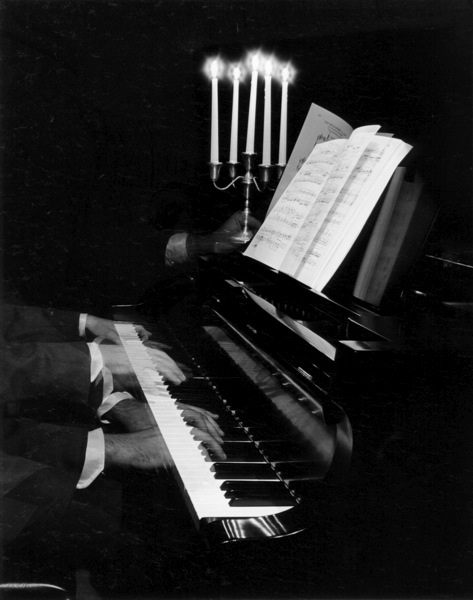Using Flash for Multiple Exposure
Typically, a camera that offers multiple-exposure capability will hold the film in place while you recock the shutter, enabling you to re-expose the same piece of film the next time you press the shutter release. Despite insisting on having this capability in the cameras I would buy, I rarely (intentionally) used this mode of multiple exposure, Instead, I used two different techniques for multiple exposure (and both techniques brought me recognition in the Orange County Fair — something I was quite proud of as a teenager). For one image, I created a multiple exposure in the darkroom. First I printed a slide of a soft-focus portrait, then (without changing the paper), I printed a slide of multiple flowers. The result was a rather dreamy representation of the model.
The image on this page was an 8x10 printed on Ilford Galerie grade 3 paper (which, being silver-rich, preserved very nicely), and scanned with an Epson 4870 flatbed scanner at 300 dpi. To produce the original image, I had a Canon F-1n with a Vivitar 28mm lens mounted on a Slik U-212 tripod. To maximize the depth-of-field, and to minimize the light contribution from the candles, I stopped the lens down to f/16. I also had my friend and fellow photographer, Mike Fulton, hold an untethered Vivitar 285 flash overhead and aimed downward, toward the keyboard. The shutter speed was set to ‘B’ (for “Bulb”, to stay open indefinitely). The candles were the only ambient light source, and provided a sufficiently low level of illumination that my hands did not blur during the long exposure. I sat down on the bench, started to play, and then had Mike start the exposure. A few times over the next minute or so, when my hands were in interesting positions, I asked Mike to pop the flash to freeze my hands in those positions. Then I had Mike close the shutter. Technically, this was a single exposure in the sense that the shutter opened and closed exactly once, but there were multiple light contributions to the exposure, including the continuous light from the candles and then a few discontinuous bursts from the flash.
This was image was created in pre-digital days, and I had a lot of flash-induced extraneous illumination in the image, particularly in the upper left-hand corner of the frame where there was a white wall and a light switch. I used Farmer’s Reducer on that corner of the negative to erase those unwanted features. Although the subject was naturally high-contrast, I still ended up with more grey detail than I wanted, so I used an higher-than-normal contrast grade of paper for the printing. With today’s technology, this darkroom work would have been done much faster, more precisely, and more forgivingly with Photoshop. However, for the actual exposure of the image, there is not much that I would do differently with today’s technology.
Similar effects can be obtained by taking long exposure pictures at night and using a flashlight to temporarily illuminate certain subjects; I’ve seen this done for group portraits at night, with each face getting a few seconds of flashlight time during a 1-minute exposure. In fact, as an interesting twist, I’ve seen someone move from one side of the group to the other and have his face illuminated two separate times by the flashlight, giving the illusion that he either had an identically dressed twin or else was in two places at the same time.
As an interesting bit of trivia, pianists looking at this image might notice the mismatch between the hand positions and the printed music. I chose to play a Liszt etude because it has a lot of movement across the keyboard. The piece was memorized so I didn’t need the music to be able to play it. However, I wanted printed music in the image (for compositional purposes as well as to show a hand turning a page). I couldn’t find the sheet music for the Liszt, so I put a book of Beethoven sonatas on the music stand. Could you tell?

Tip of the Week
2007.04.09

